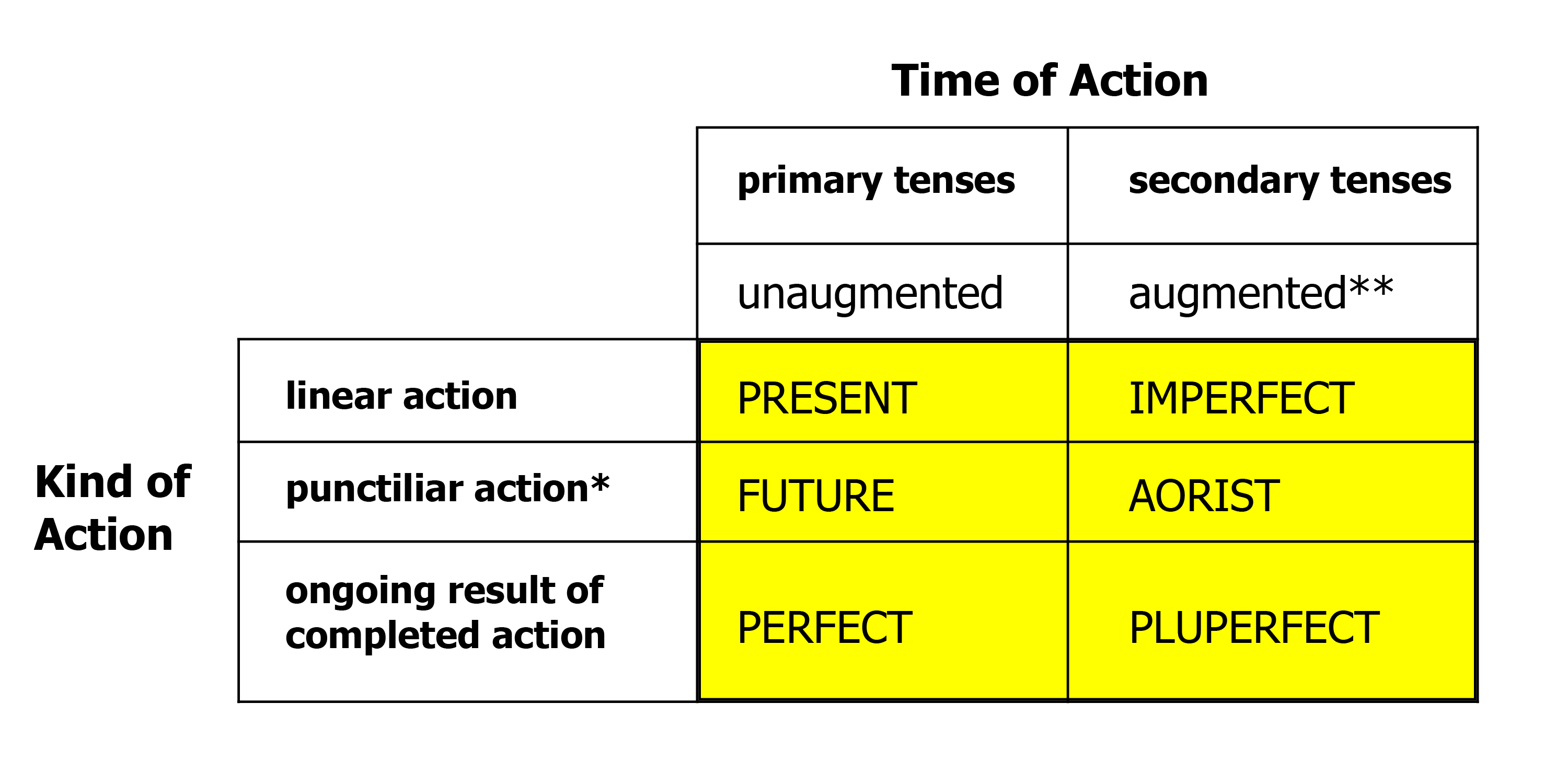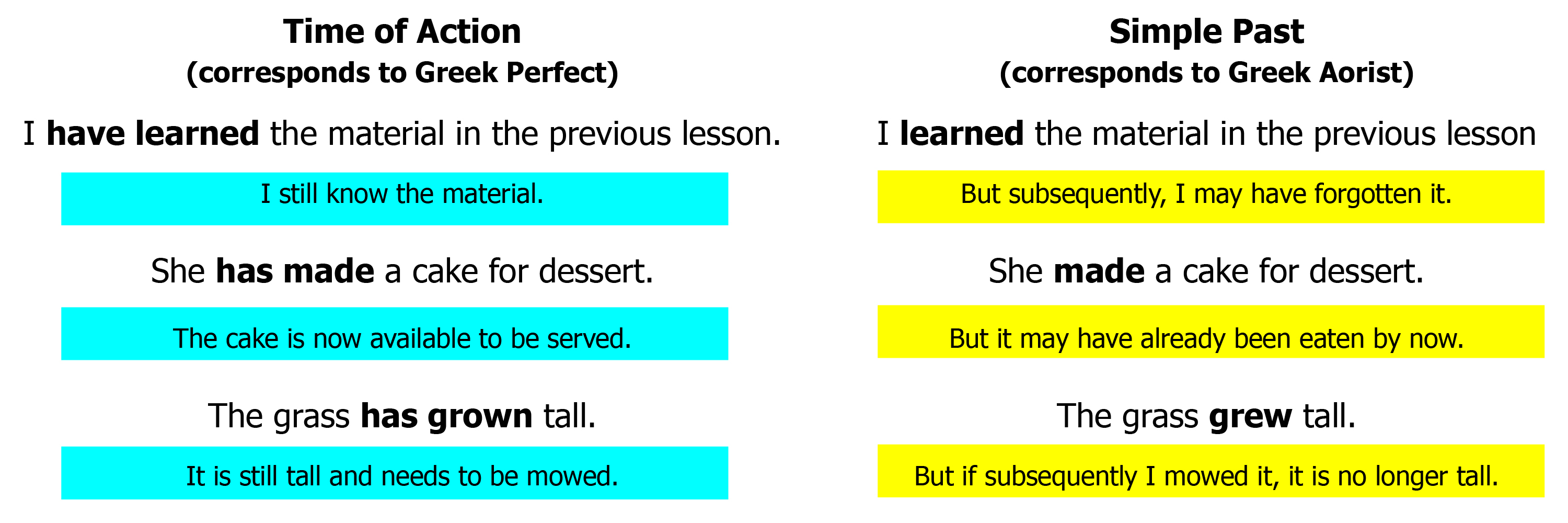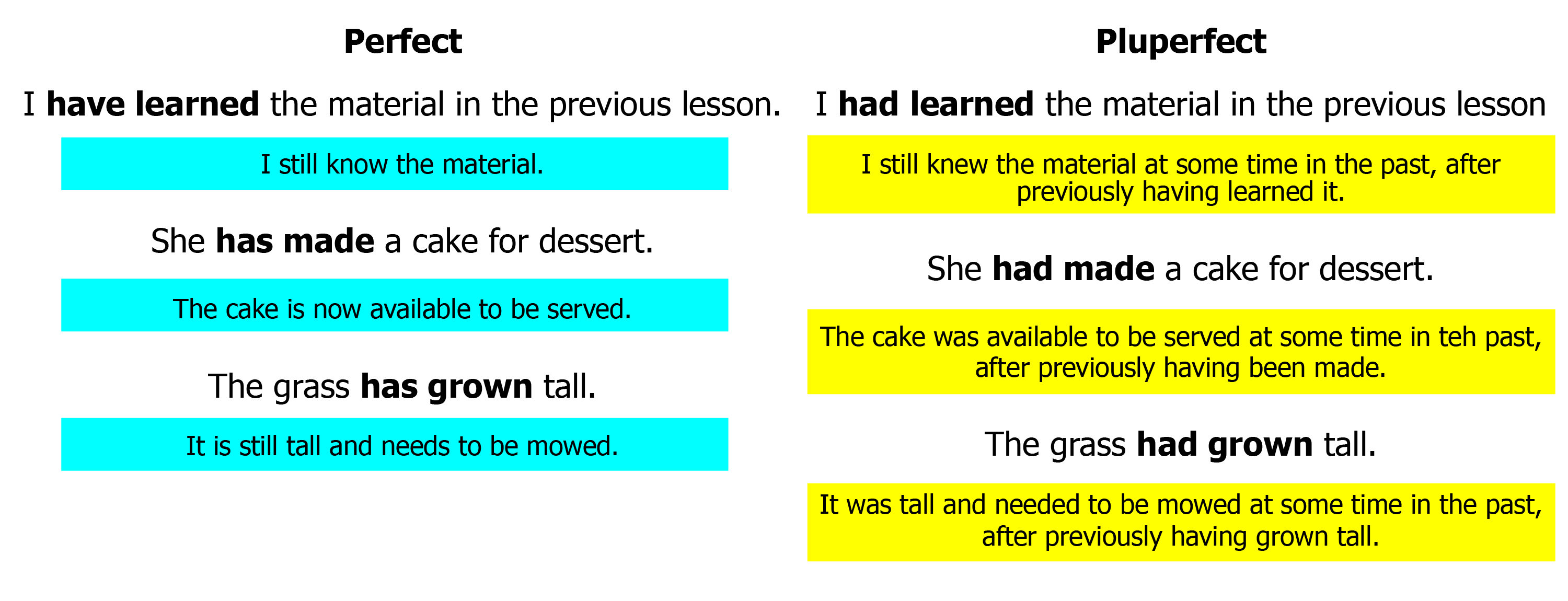Lesson 3 – Overview of the Tenses, Perfect Active, Pluperfect Active, οἶδα & ᾔδειν, Condition Contrary to Fact
Overview of the Tenses
The following matrix may help you conceptually organize tenses in a useful way. For the purpose of this matrix, Time of Action is divided into two categories only, one category for the tenses having to do with present or future time in the indicative mood, and one category for the tenses having to do with past time in the indicative mood. This is the distinction between primary and secondary tenses, and generally speaking, this is the distinction indicated by the presence or absence of the augment.

* Remember, neither the Future nor the Aorist imply that the action described is actually punctiliar or point-in-time, though it may be said that the speaker considers the action as if it were point-in-time.
** The augment occurs only in the indicative mood, and this is the only mood in which absolute time is indicated by tense. In the pluperfect, the augment is often omitted.
Perfect Tense
In Course I, Lesson 2, we made note of three kinds of action: linear, punctiliar, and ongoing result. The Perfect Tense indicates ongoing result.

If you remember that the meaning of the word perfect is complete, then you can remember that the perfect tense has to do with completed action. But the perfect tense is a primary tense because it emphasizes the present, or ongoing result of a completed action. The perfect tense in Greek corresponds to the perfect tense in English, and is illustrated in the following sentences. In each sentence, observe what is suggested about the present status.
I have learned the material in the previous lesson.
This indicates a present status: I still know the material in the previous lesson.
She has made a cake for dessert.
The implication is that the cake is now available to be served for dessert.
The grass has grown tall.
It is still tall and needs to be mowed.
Contrast these same sentences with similar sentences wherein a simple past tense is used.

Perfect tense (active voice) is formed using the 4th principal part
Compare the simplified table of principal parts below with the table in the back of your text book.
| principal part | λύω | λύσω | ἔλυσα | λέλυκα | λέλυμαι | ἐλύθην |
| tense/voice combinations formed | present imperfect | future act/mid | aorist act/mid | perfect act. pluperfect act. | perfect mid/pass pluperfect mid/pass | aorist pass future pass |
Reduplication
One of the most recognizable features of many perfect tense verbs is a prefix called reduplication. In the perfect tense forms of regular verbs beginning with consonants, this prefix usually consists of the same letter as the initial stem consonant followed by the letter epsilon. Compare the Perfect Active Indicative forms with the Present Active Indicative forms for the following verbs. The reduplication in each Pft. Act. Ind. form is highlighted.
| pres. act. ind. | pft. act. ind. |
| λύω | λέλυκα |
| γράφω | γέγραφα |
| πιστεύω | πεπίστευκα |
It should not be supposed that the present verb stem and perfect verb stem will always be as similar as they are in the examples given above. In the following examples, the internal differences in the stems are significant. Still the reduplication is obvious.
| pres. act. ind. | pft. act. ind. |
| βάλλω | βέβληκα |
| πείθω | πέποιθα |
| πέμπω | πέπομφα |
When a stem begins with a rough mute, either, θ, φ, or χ, the reduplication is a bit different, but is predictable.
θ reduplicates using τ
φ reduplicates using π
χ reduplicates using κ.
Consider the following examples:
| pres. ind. | pft. ind. |
| θλάω | τέθλακα |
| θνῄσκω | τέθνηκα |
| φυλάσσω | πεφύλαχα |
| χράομαι* | κέχρημαι* |
* These are middle voice verbs, but will often be translated using an active voice in English. See the discussion of so-called deponent verbs in lesson 4.
In verbs beginning with vowels, reduplication often looks like the augment of the secondary tenses, i.e., the initial vowel is lengthened. Consider the following examples:
| pres. ind. | pft. ind. |
| ἁμαρτάνω | ἡμαρτηκα |
| ἐλπίζω | ἤλπικα |
The perfect stem of many other verbs is not so predictable. You will need to begin paying attention to the principal parts as listed in a lexicon, and commit these to memory.
Stem suffix
Perfect tense verbs can be divided into two categories. Verbs in one category, characterized by κα in the stem suffix prior to the personal ending, are called 1st perfects. Verbs in the other category are called 2nd perfects.
Personal endings
The personal endings of the Perfect Active are similar to the secondary tense endings.
| sing. | pl. | |
| 1st pers. | – | -μεν |
| 2nd pers. | -ς | -τε |
| 3rd pers. | -(ν) | -σι(ν) |
Notice that the moveable ν may occur in both the 3rd person singular and in the 3rd person plural.
1st perfects look very much like 1st aorists, with κα instead of σα.
| sing. | pl. | |
| 1st pers. | -κα | -καμεν |
| 2nd pers. | -κας | -κατε |
| 3rd pers. | -κε(ν) | -κασι(ν) |
Compare 1st perfect act. ind. endings with 1st aorist act. ind. endings, noting that if the κ of the perfect tense were a σ, thesetense suffix / personal ending combinations would look alike except in the 3rd person plural.
This, then, is the conjugation of the perfect active indicative of λύω…
| singular | ||
| 1st person | λέλυκα | I have loosed |
| 2nd person | λέλυκας | you have loosed |
| 3rd person | λέλυκε(ν) | he, she, it has loosed |
| plural | ||
| 1st person | λελύκαμεν | we have loosed |
| 2nd person | λελύκατε | you (pl.) have loosed |
| 3rd person | λελύκασι(ν) | they have loosed |
2nd perfects are similar but do not have the κ. Consider the conjugation of the perfect active indicative of γίνομαι…
| singular | ||
| 1st person | γέγονα | I have become |
| 2nd person | γέγονας | you have become |
| 3rd person | γέγονε(ν) | he, she, it has become |
| plural | ||
| 1st person | γεγόναμεν | we have become |
| 2nd person | γεγόνατε | you (pl.) have become |
| 3rd person | γεγόνασι(ν) | they have become |
Again, remember that for both 1st perfects and 2nd perfects, the forms cannot always be completely explained in terms of reduplication and tense suffix / personal ending combinations. One cannot start with a present stem (1st principle part), and after making these modifications, assume that he has a perfect tense verb. There are other less predictable ways in which the perfect stem may vary from the present stem, as in the case of γίνομαι above. I have put together a list of verbs that occur frequently in the New Testament. For each verb, every principal part that appears in the New Testament is given. As you become familiar with each of these verbs, study the principal parts, taking care to notice the ways in which the stems differ internally for a given verb.
Pluperfect Tense
The Pluperfect Tense is a secondary tense. It is used of action that had been completed prior to some point in the past. It is the Perfect Tense adjusted backward in time.
Consider the the following sentences, noting the state of completed action suggested by each tense.

Pluperfect tense (active voice) is formed using the 4th principal part
Reduplication
The pluperfect tense shows the same reduplication as is seen in the perfect tense.
Augment
Being a secondary tense, the pluperfect tense may have the augment in the indicative mood. However, the augment is often omitted.
Stem suffix
Pluperfect tense verbs can be divided into two categories. Verbs in one category, characterized by κει (κ followed by the coupler letters ει) in the stem suffix prior to the personal ending, are called 1st pluperfects. Verbs in the other category lack the κ and are called 2nd pluperfects.
Personal endings
The personal endings of the Pluperfect Active are the secondary tense endings we previously learned, but with σαν rather than ν in the 3rd person plural.
| sing. | pl. | |
| 1st pers. | -ν | -μεν |
| 2nd pers. | -ς | -τε |
| 3rd pers. | – | -σαν |
This, then, is the conjugation of the pluperfect active indicative of λύω…
| singular | ||
| 1st person | λελύκειν | I had loosed |
| 2nd person | λελύκεις | you had loosed |
| 3rd person | λελύκει | he, she, it had loosed |
| plural | ||
| 1st person | λελύκειμεν | we had loosed |
| 2nd person | λελύκειτε | you (pl.) had loosed |
| 3rd person | λελύκεισαν | they had loosed |
Because there are only 21 verbs in the New Testament that occur as pluperfect active indicatives, we can list them here. Notice that the characteristic ει is seen without exception, even in the 2nd pluperfect forms. In the 3rd person singular forms, this may look like the personal ending of the Present Active Indicative. It is not. Remember that the pluperfect is a secondary tense, and therefore has secondary personal endings, for which there is no 3rd person ending. The ει seen in the 3rd person singular forms are the coupler letters of the pluperfect active forms with no personal ending attached.

οἶδα & ᾔδειν
Although οἶδα is 2nd perfect in form, it is used with a present tense meaning. The pluperfect form ᾔδειν is used with an imperfect tense meaning.
| singular | ||
| 1st person | οἶδα | I know |
| 2nd person | οἶδας | you know |
| 3rd person | οἶδε(ν) | he, she, it knows |
| plural | ||
| 1st person | οἴδαμεν | we know |
| 2nd person | οἴδατε | you (pl.) know |
| 3rd person | οἴδασι(ν) | they know |
| singular | ||
| 1st person | ᾔδειν | I was knowing |
| 2nd person | ᾔδεις | you were knowing |
| 3rd person | ᾔδει | he, she, it was knowing |
| plural | ||
| 1st person | ᾔδειμεν | we were knowing |
| 2nd person | ᾔδειτε | you (pl.) were knowing |
| 3rd person | ᾔδεισαν | they were knowing |
Condition Contrary to Fact
Remember that the typical construction of Type II conditional sentences is
εἰ …[secondary tense indic. verb]…, …ἄν…[secondary tense indic. verb]…
In Lesson 1 (Level II) we studied the used of the imperfect tense in such sentences. We observed the following:
- Type II conditional sentences use secondary tenses in the indicative mood, usually in both the protasis and in the apodosis, but do not necessarily indicate past time.
- When the imperfect tense is used in such sentences, present time is regularly in view.
- Type II conditional sentences often have ἄν in the apodosis.
- The speaker means to indicate that the protasis is contrary to fact.
- The English translation will use the subjunctive mood involving a past tense verb form in the protasis.
Again, note that when the imperfect tense is used, the speaker does not necessarily mean to indicate past time. In Type II conditional sentences (condition contrary to fact) the imperfect tense is regularly used when present time is in view.
But when other secondary tenses are used (aorist or pluperfect), past time is indicated. Consider Mt. 11:21 where Jesus considers the hypothetical repentance of Tyre and Sidon hundreds of years earlier, a repentence which in fact had not occurred:
οὐαί σοι, Χοραζίν, οὐαί σοι, Βηθσαϊδά·
ὅτι εἰ ἐν Τύρῳ καὶ Σιδῶνι ἐγένοντο
αἱ δυνάμεις αἱ γενόμεναι ἐν ὑμῖν,
πάλαι ἂν ἐν σάκκῳ καὶ σποδῷ
μετενόησαν.
“Woe to you, Chorazin, woe to you, Bethsaida;
because if among Tyre and Sidon had been done
the powers which were done among you,
long ago in sackcloth and ashes
they would have repented.”
Notice carefully the tense of ἐγένοντο in the protasis and the tense of μετενόησαν in the apodosis. Both verbs are aorist tense. Because secondary tense verbs are used, you know the protasis is assumed to be contrary to fact. Tyre and Sidon did not repent. Because an aorist or pluperfect is used rather than an imperfect, you know the speaker has past time in view and you translate “had been done” rather than “were done” in the protasis and “would have repented” rather than “would repent” in the apodosis.
